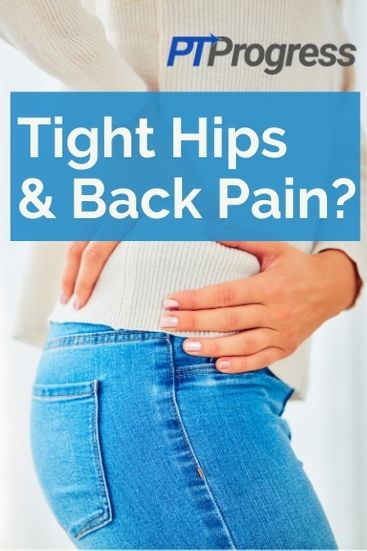
Could tight hips be causing your back pain? How can you tell for sure whether or not your hips are even tight in the first place?
Well, first be honest with yourself when you answer this question…how much of your day do you spend sitting? Sitting at work. Sitting in the car. Sitting in front of the TV.
It’s no secret that posture plays a role in our wellbeing. That is true not only for standing, but sitting as well. What does all of this sitting do to our muscles, our posture, and our overall health?
Well, prolonged sitting can result in stiff and tight hips. This is particularly true of your hip flexors, as these are kept in a shortened position while sitting in a chair. These tight muscles, in turn, can contribute to the development of low back pain by influencing your posture and even the way you stand or walk.
A systematic review in 2019 found a correlation between limited hip mobility and low back pain; although this evidence was admittedly not very strong.1 Another study in 2015 found that improving hip mobility resulted in decreased low back pain.2 Although it should be noted that in this study, it was found that hip strengthening was the more effective treatment.
So, let’s start by
- Identifying which muscles we’re going to be talking about
- Discussing how to tell which of these muscle are tight
- Teaching proper stretches that you can start at home
Hip Anatomy: A Quick Look
This is not meant to be an anatomy class, so let’s keep this nice and simple.
Hip Flexors
This is a broad term used to refer to the muscles at the front of your hip/thigh. While most people refer to their “quads” as hip flexors, in reality only your rectus femoris flexes the hip. Your rectus femoris goes from the front of your pelvis down to your kneecap.
Other hip flexors would include your iliopsoas (which runs from your spine down to the front of your femur), your sartorius (which crosses over the front of your thigh from your pelvis to the inner side of your tibia), and your tensor fascia latae (the large muscle that connects from your pelvis to your tibia via the infamous IT band).
Hamstrings
A term that just about everyone knows. This is a group of 3 muscles that run down the back of your thigh. While hamstrings bend your knee, they also work with your glutes to extend your hip. Because of this close association with your glutes, they are intimately related to the mechanics of the pelvis and lumbar spine.
Glutes/Piriformis
You probably don’t need me to tell you what your glutes are…butt, I’m going to tell you anyway. There are 3 gluteal muscles: maximus, medius, minimus. These muscles move your hip backwards (extension) and out to the side (abduction).
However, there is a group of muscles that lie beneath your glutes that are collectively referred to as your “deep hip lateral rotators”. Your piriformis muscle is one of these deep hip lateral rotators.
How to Tell If Your Hips Are Tight
(By the way, the nice thing about these tests is that in many cases, if your hips are indeed tight, the test becomes the stretch!)
Hip Flexors
One of the easiest ways to assess hip flexor tightness (though not a particularly accurate assessment) would be to lie on your back with your legs out straight. If your lower back arches excessively up off the floor, this could be an indication that your hip flexors are tight (though it’s hard to tell on your own because you are supposed to have a little bit of an arch)
Another, far more accurate, way to measure tightness would be to take yourself through what is called the Thomas Test. Lie on your back at the end of your bed. Hold one knee to your chest and allow the other leg to drop off the side/end of the bed. If your thigh is unable to reach the bed or you notice an uncontrollable extension of your knee, that would be an indication of possible iliopsoas or rectus femoris tightness respectively.
Hamstrings
First I want to say, if your instincts are to bend forward to try to touch your toes to see if your hamstrings are tight…your instincts would be wrong. While your ability to touch your toes is influenced by your hamstrings, it is also influenced by the mobility of your spine.
A better way to isolate the hamstrings would be to lie on your back with both legs out straight and place a strap (dog leash, rope, beach towel, etc) around one foot. Use your arms to pull one leg up with the strap while keeping your lower back flat on the ground. If you’re unable to raise your leg to 80°, that would be an indication that your hamstrings may be tight (it may help to have someone assess this for you from the side….or better yet, have them be the one to lift your leg).
Glutes/Piriformis
This is harder to test for at home. That’s okay though because in this physical therapist’s humble opinion, those 3 glute muscles I previously mentioned are very rarely truly tight.
While the glute may not often be tight, that is not the case when it comes to the deep hip lateral rotators. These muscles are frequently tight in people who consistently sit “criss-cross” or play sports that require a lot of hip activity such as cycling and hockey. If you look down at your feet while you’re standing and your toes point outward, there is a chance your external rotators are tight.
A slightly more objective way of checking for tightness on your own at home would be to lie down on your stomach, bend your knees to 90°, and allow your feet to fall out to the side. Anything short of a 45° angle of your lower leg would be considered tight (again it may help to have someone eyeball this for you from behind).
Hip Mobility Stretches
Hip Flexor Stretch
Easy: The Thomas Test/Stretch
- Lie down on your back with your hips positioned at the edge of the bed
- Pull one knee toward your chest and allow the other to hang off the end/side of the bed, being sure to keep your lower back flat on the bed
- You should feel a stretch at the front of the hip of the leg hanging off the bed…that would be your iliopsoas…actively bend your knee to place a greater stretch on the rectus femoris
- Perform this stretch 4-6x on each leg with a 30 second hold each time
Advanced: Kneeling Stretch
- Place a pillow, cushion, or rolled up towel on the floor to spare your knees for this one
- Kneel down with one knee on the cushion and the other leg positioned out in front of you- knee bent to 90° and your foot flat on the floor
- Tilt your pelvis backwards, or “tuck your butt underneath you”, to prevent your pelvis from tilting forward…some of you may feel a stretch at the front of your hip just doing this
- With your hands on your hips to ensure you maintain this pelvic tilt, gradually shift your body forward…putting more weight through your front foot; be sure to keep your your upper body straight but not leaning back to the point that your back arches
- This is primarily a stretch for your iliopsoas, but you can place a strap around your foot and pull to bend your knee to put a great stretch on the rectus femoris if tolerated
- Perform this stretch 4-6x on each leg with a 30 second hold each time
Hamstring Stretches
Easy: Supine w/ Strap
- Lie down on your back with both legs straight
- Place a strap of some kind (dog leash, rope, beach towel) around one foot
- Use your arms to pull your leg into the air until you feel a pull in the back of your leg
- Perform this stretch 4-6x on each leg with a 30 second hold each time
Advanced: At Stairs
- The reason this one could be considered advanced for some, is because you have to be mindful of the position of your back
- Stand in front of the stairs and put the heel of your affected leg on a step (1st, 2nd, or 3rd depending on your flexibility)
- Keep your hands on your pelvis or one hand on the railing for stability
- Lean forward by tilting your pelvis forward and keeping your back straight
- DO NOT bend in your back
- Lean until you feel a stretch in the back of your thigh, stop if these symptoms go down to your foot/toes
- Perform this stretch 4-6x on each leg with a 30 second hold each time
Glutes/Piriformis
Easy: Figure 4
- Lie on your back with your knees bent
- Rotate one leg to place your ankle on the thigh of your other leg, so that your legs resemble the shape of the number 4
- Using your hands, or a towel behind your thigh if you can’t reach, grab the leg that still have a foot on the floor/bed and pull toward your chest until you feel a stretch in the back of your hip on the rotated leg
- Perform this stretch 4-6x on each leg with a 30 second hold each time
Advanced: Modified Pigeon Pose
- Standing at the edge of your bed, couch, or a low table/counter, lift up and rotate one leg to place your entire thigh and shin on that surface
- Keep your other foot on the ground
- While keeping your spine straight, lean forward over your bent leg until you feel a stretch in the back of your hip on the rotated leg
- Perform this stretch 4-6x on each leg with a 30 second hold each time

This article was written by Dan Murphy DPT, OCS. Dan graduated from Washington University in St. Louis in 2016 and lives just outside of Chicago with his wife and 2 year old son; though he and his wife are expecting a daughter in a few months! He enjoys playing board games and any outdoor activities with friends and family.
References
- Avman MA, Osmotherly PG, Snodgrass S, Rivett DA. Is there an association between hip range of motion and nonspecific low back pain? A systematic review. Musculoskelet Sci Pract. 2019;42:38-51. doi:10.1016/j.msksp.2019.03.002
- Winter S. Effectiveness of targeted home-based hip exercises in individuals with non-specific chronic or recurrent low back pain with reduced hip mobility: A randomised trial. J Back Musculoskelet Rehabil. 2015;28(4):811-825. doi:10.3233/BMR-150589

